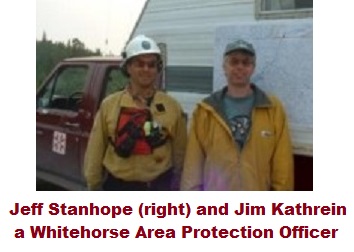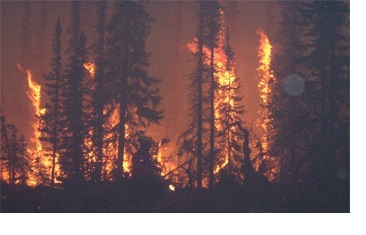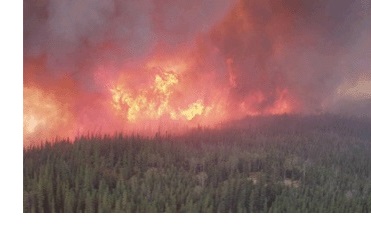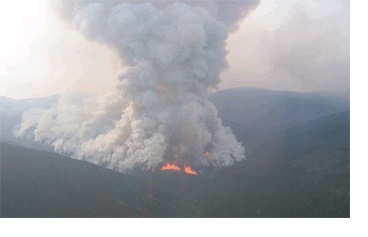
|
2004
The things we do: Fighting fires in the
Yukon and northern BC
The last bulletin we received from Yukon Wildland Fire Management mentioned 229 fires in the Yukon so far and a loss of more than 1,300,000 hectares of forest. Thatís more than twice the size of Prince Edward Island gone up in smoke, and growing.
And our own Jeff Stanhope was in the thick of it providing on-the-ground emergency telecommunications. Hereís an abridged version of the report he sent in. Get your map out. ďI just got back around midnight last night after a good five days of fairly intense communications work at the Swift River/ Swan Lake fire.
This continued for two days at one location near a mosquito-infested highway pull-out and then we moved up the road to the McNaughton microwave site 7(km west of Swift River), once it was deemed safe enough to do so. The McNaughton Microwave site was the site originally in danger.
Major communications responsibilities also included relays to the Dease Lake, BC, fire base for aircraft check-ins, air traffic advisories and other assorted BCFS-related matters such as logistical requests.
It was not until Saturday that a forestry repeater finally showed up. This reduced the load considerably on the EMO communications team, but still did not release us from other required relayings of communications such a aircraft flight checks to Dease Lake and relays from Yukon Fireline (the nearby Yukon fire in Pine Lake) to the BC team.
Itís a very difficult link to the Dease radio system. Our shot was obstructed by several mountains over the 160 kilometre path and often the smoke would attenuate the VHF signal by several DB, rendering the link unuseable at times. As it was, we alternated between a 210C4 large antenna (highway location) and a normal roof mount antenna.
The radios we used were the specialized equipment, repeaterized version of the high powered Syntor X 9000, and were programmed on the fly as required by the changing site situations.
After five full days of hectic, sleep deprived work, the EMO team was really required to return to Whitehorse at some point. After three days of "next day we'll get out for sure", we finally reached an agreement to disengage. The EMO communications teams would have asked for relief from Whitehorse sooner, but each day we thought the next one would be the last.
Most highway closures only lasted about 2-3 hours but still involved 100's of RV, transports, and other vehicles. When opening the highway, pilots were used and, after that, staged and controlled releases to avoid aggressive traffic mayhem. Most every motorist was well behaved with only limited shoving and pushing at the Swift roadblock when some could not understand why we could go through but not them.
All in all, the whole operation was a model of interdepartmental and inter-jurisdictional cooperation. Agencies shared and continue to share resources as required, without a thought to who "owned" them. This was the case both with the fire at Swan Lake (BC), but also between Swan and the Pine Lake fire nearby (YT). I don't know if we will be required again, but it seems unlikely at this time as the fire seems to be getting under better control all the time though probably won't be completely out until the fall."
|
|
Links - Liens
|






 For several hair-scorching days,
For several hair-scorching days,
 The Yukon Joint Emergency
Operations Communications Centre was activated around 1:30 AM on Thursday. I
was called out around 3:30 AM on the 24th and was able to load up and get
underway with a fellow EMO volunteer by 7:30. I arrived on scene around 10:00
AM and set up tactical relay communications for forestry and provided an
interagency communications liaison with Highways and the RCMP.
The Yukon Joint Emergency
Operations Communications Centre was activated around 1:30 AM on Thursday. I
was called out around 3:30 AM on the 24th and was able to load up and get
underway with a fellow EMO volunteer by 7:30. I arrived on scene around 10:00
AM and set up tactical relay communications for forestry and provided an
interagency communications liaison with Highways and the RCMP.  We were doing communications that
were operational in nature and that should have been done by the agencies
themselves, but it was impossible for us to leave, because the BC people were
being stretched past the breaking point across the province and unable to get
any logistics people.
We were doing communications that
were operational in nature and that should have been done by the agencies
themselves, but it was impossible for us to leave, because the BC people were
being stretched past the breaking point across the province and unable to get
any logistics people.  In terms of highway closures, we
had to initiate this several times based on instructions from the forestry
crews either because of impending fire jumps or the thick smoke, which often
dropped our viability down to less than 100 meters. At one point in fact, we
were "trapped" at the Swan Lake Lodge when the fire had some extreme
unexpected behaviour and roared past within 100 Meters of the highway turn-off
to where we were, or about 250-300 meters away. The Ontario crews who were
with us were very calm and confident that their building and forest sprinkler
system would hold, which it did just fine, and the fire just went past us.
This site, by the way, had already been secured by the Yukon Team well before
the BC and Ontario folks could get set up and they essentially saved the
resort by creating a ring of blackened forest. The new crews were simply
reinforcing this barrier.
In terms of highway closures, we
had to initiate this several times based on instructions from the forestry
crews either because of impending fire jumps or the thick smoke, which often
dropped our viability down to less than 100 meters. At one point in fact, we
were "trapped" at the Swan Lake Lodge when the fire had some extreme
unexpected behaviour and roared past within 100 Meters of the highway turn-off
to where we were, or about 250-300 meters away. The Ontario crews who were
with us were very calm and confident that their building and forest sprinkler
system would hold, which it did just fine, and the fire just went past us.
This site, by the way, had already been secured by the Yukon Team well before
the BC and Ontario folks could get set up and they essentially saved the
resort by creating a ring of blackened forest. The new crews were simply
reinforcing this barrier.